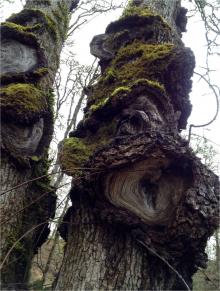Cause Neonectria ditissima (formerly Nectria galligena), a fungus, occasionally causes a perennial target-shaped canker on the trunk and limbs of Oregon white oak. In response to infection, the tree forms a callus ridge around the initial canker. The following year the fungus invades the heathy tissue beyond the callus ridge, and the tree forms another callus ridge. The repeating process of fungus growth and callus formation give the canker the appearance of a target with concentric rings. Pruning wounds or other types of mechanical injury serve as entry points for the fungus. Trees with stem cankers are subject to breakage at the canker when the canker affects more than approximately 30% to 40% of the stem diameter. Observations suggest that certain individual Oregon white oaks are highly susceptible, while most are not.
Symptoms The canker initially appears as a slightly sunken oval or round lesion on the stem. Round to oval woody target-shaped canker. Tiny red to dark brown fruiting bodies (perithecia) may be visible at the canker margin.
Cultural control
- Prune only during dry weather.
- Prune out infected branches as soon as possible after detection.
- In young stands, remove infected trees.
Reference Sinclair, W.A., and Lyon, H.H. 2005. Diseases of trees and shrubs, 2nd ed. Cornell University Press.


